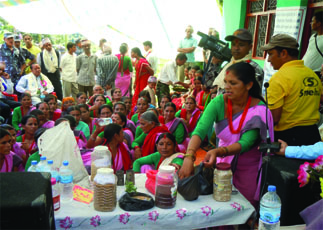The Hill Maize Research Project (HMRP- IV) covers 20 hill districts from the east to the west of Nepal, and is jointly funded by SDC and USAID-Nepal. The overall goal of HMRP-IV (2010-2014) is to improve the food security and income of farm households in the hills of Nepal, especially of the poor and disadvantaged groups.
In HMRP IV, aside from the maize research and development activities, market assurance for maize seed produced under community based seed production (CBSP) groups in a value chain system, and enhancing management and marketing competencies of partners are added activities in this phase. To improve the seed marketing, Phase IV has conceptualized various strategies such as targeting local level seed market outlets (agrovets, cooperatives, seed companies), creating awareness on use of improved maize varieties, providing market information to clients on time, provision of seed revolving funds to selected CBSP groups, advocacy for getting local government’s block grant to purchase maize seed produced by CBSP groups and cooperatives, establishing effective seed marketing network at the district and project level, onboard more number of private organizations in seed business, adopt demand driven and technology supported seed production programs, advocacy for contract seed production, market infrastructure support, graduation of CBSP groups to cooperatives and to seed company, establishing cooperative/ private sector led seed production and marketing system, etc.
The HMRP in collaboration with National Maize Research Program (NMRP) completed a 20 days training course on maize seed production technologies (15 days) and seed business plan development and marketing (5 days). The training was organized from 27th March to 16th April 2012 at NMRP, Rampur. A total of 31 participants (11 women) participated in this training. The participants were the members of CBSP groups of HMRP. They will work as community seed promoters in their respective groups afterward.
The training was conducted in two thematic areas. First on maize seed production technologies which covered complete agronomic practices on maize seed production, primarily maize morphology, farmers’ practice in maize varietal development, source seed production technologies, crop management technology including insect pest management, improved seed production through CBSP, seed quality control and truthful labeling, etc. The second area was on maize seed business plan development and seed marketing, which covered seed marketing strategies of HMRP, concepts on agriculture marketing, cost of maize seed production including detail exercises, maize seed value-chain analysis, maize seed business plan development (concept and practical), book keeping at CBSP group level, approaching CBSP groups to local state (VDC/DDC) funds and importance of GESI in CBSP approach, introduction on cooperatives and private company, and basic legal requirements for their establishment.
In the last day of the training course a comprehensive action plan was prepared by each trainee and presented in group. Pre and post course evaluation of participants were conducted in both courses and the first-ranked candidate was awarded. Dr. K. B. Koirala, National Coordinator of NMRP chaired the closing session of the training. He appreciated the training course conducted by the HMRP and emphasized the high importance of this type of training in the practical field. Dr. G. Ortiz-Ferrara, HMRP Team Leader, thanked all participants of the training, the training coordinator and resource persons for their help and cooperation to make this course successful. Finally, Dr. Koirala and Dr. Ferrara jointly distributed the certificates and training kits to all participants.

















